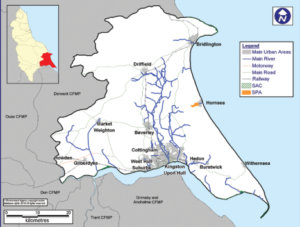Living with Water Partnership
Kingston Upon Hull (known commonly as Hull), a city of 260,000 people, is located on the north bank of the Humber Estuary in the heart of the East Riding of Yorkshire. Due to both physical geography and a complex drainage system the city is at risk from extreme flood events and the communities are amongst the most vulnerable to climate risks in the UK. In 2007 and 2013, Hull and the East Riding of Yorkshire were severely impacted by flood events. As a response, the Living with Water partnership was founded in which key stakeholders are working together to develop and deliver a master plan for the city which puts water resilience at its centre. Through a number of activities focusing on innovative and creative engineering, public engagement and education, further research projects and global cooperation, the partnership aims to reduce the impact of flooding and increase the resilience of the city and its communities.
1. The Problem
Located on the north bank of the Humber Estuary in the heart of the East Riding of Yorkshire, 90% of Kingston Upon Hull – commonly abbreviated to Hull – is located below sea level at high tide and is ranked the second most vulnerable city after London for flooding. In 2007, Hull and the East Riding of Yorkshire were severely impacted by a flood event that damaged approximately 8,600 residential properties, 1,300 businesses and 91 out of 99 schools. In December 2013, a storm surge on the North Sea moved into the Humber Estuary which flooded over 400 properties.
The high vulnerability can be attributed to the nature of the landscape: imagine Hull as a bowl, the sides are the high land of the Yorkshire Wolds to the north and west. The frontages built by the Vikings along the Humber banks in the south, protect the city by keeping high tides out to prevent flooding but they also act as a dam for the surface water that must discharge into the estuary. Climate change further increases the threat of flooding, as intense storms become more frequent and sea levels are rising.
A combination of soil type, high groundwater levels, rich archaeological significance and a history of contaminated land proved challenging conditions for surface water management, driving up the costs of sustainable urban development and implementation. Although the Humber is the largest trading estuary in the UK (by tonnage) and the fourth largest in northern Europe, Hull has been identified (in 2015) as the third most deprived Local Authority (LA) area in the UK. Recent flood events have functioned as a warning to put measures into place to manage the water risks of the area. The complex and unique nature of flood risk in Hull and East Riding underpins the essential need for Risk Management Authorities to work together.
What are the Drivers for Action?
For more information on the Drivers for Action visit the Action Agenda for Basin-Connected Cities
| Extreme Events | Declining water quality | Water availability |
| ☐Public health hazards
|
☐ High operating costs
|
☐ Water supply disruption
|
| ☒ Damage to infrastructure | ☐ Loss of credibility and trust | ☐ Constraints to growth |
| ☒ Economic activities and supply chain disruption | ☐ Environmental, cultural and health impacts | ☐ Declining quality of life |
2. The solution
To reduce the impact of flooding, there has been significant investment from each of the Risk Management Authorities across Hull and the East Riding. The Living with Water (LWW) partnership is a collaboration between Yorkshire Water, Hull City Council, East Riding of Yorkshire Council and the Environment Agency and has won the prestigious British Quality Foundation’s Collaboration Award. The long term ambition of the partnership is to work collaboratively with the public sector, private sector and communities to co-design and develop water sensitive urban regeneration which manages flood risk and enhances the environment and well-being of the region alongside flooding. The aim is to reduce vulnerability to flooding and increase resilience through infrastructural projects and activities at the community level.
Public engagement and education programmes
Positive culture change and social adaptation have been a major focus for the partnership in its first 18 months. In October 2018, the Hulltimate Challenge city-centre obstacle course took place across Hull City Centre, to positively reconnect people with the urban water environment through an interactive and educational family day in which over 2,000 participants engaged including more than 1000 school children taking part and 50 public, private and third sector organisations supporting the event. Planning for a similar event focussed on engaging with school children is currently underway.
Extensive public engagement has been undertaken by the partnership and continues to underpin the broader programme, supported by the development and dissemination of a suite of creative materials including chatterbox games for children, literature and interactive workshop-based tools. An education programme has been developed for primary school children: schools are able to book a LWW assembly or workshop both of which combine practical activities with key messages around planning and preparing for flooding. In the first 7 months of 2019, the LWW programme has delivered 153 education hours to children, engaged with over 1911 members of the public, received 228 LWW pledges and directly signed up almost 90 households to the EA’s flood warnings.
A Baseline Study was conducted by LWW and Hull University through 2018 and 2019, this provides public insight into flood resilience as well as key socio-economic data and statistics. Baseline indicators are currently being developed from this which will allow the partnership to evaluate its impact over time.
Further research projects and global collaborations
Partnering with universities including Hull, Northumbria and Sheffield, LWW has developed a series of 6 LWW PhDs and further research projects specifically focussing on areas such as telemetry integration between RMA’s; customer interaction with rainwater harvesting for multiple benefits, a baseline study of current awareness of flood risk and resilience and flood training protocols for first responders.
The LWW Partnership is successfully collaborating globally to share and learn from experiences in other cities around the world. Hull participates in the development of the CWRA (City Water Resilience Assessment) alongside Mexico City, Cape Town, Oman and Miami, that outlines a process for developing urban water resilience and provides a suite of tools to help cities manage and build their capacity to survive and thrive in the face of water-related shocks and stresses.
3. Lessons Learned
The LWW project, through its strong international, academic and business collaborations with other partners, aspires to develop and deliver a master plan for the city which puts water resilience at its centre, in which regeneration plays a significant role.
Investment in infrastructure and engineering solutions require innovation and creativity to use existing spaces differently. The partnership is looking to global best practices such as adaptive green spaces, temporary lagoons, and eco-housing, inspired by Asia’s futuristic green parks. One of such innovations is the design and construction of water resilient homes. There was a recent competition between Hull and the Royal Institute of British Architects to address the challenges of ‘Living with Water’, by seeking innovative water-resilient design ideas for major residential areas. This led to the redevelopment of Humber Quays West and Hull Arena – two of the city’s most prestigious locations that are ripe for regeneration.
Another next step includes the further development of specific water resilience focussed apprenticeships. Examples of potential apprenticeships identified at this stage include a specific Living with Water apprenticeship, architectural design, and civic planning, green roof maintenance, SuDS installation & maintenance, etc. These apprenticeships will set the Humber region as a national leader in home-grown talent in these areas identified.
Pathways for Action
For more information on the Pathways for Action visit the Action Agenda for Basin-Connected Cities
| Assessment | Planning | Implementation |
| ☒Investment in data & information systems
|
☒ Risk-based approach to planning
|
☒ Integration of natural infrastructure
|
| ☒ Linking traditional water management with science
|
☐ Water allocation mechanisms
|
☒ Economic and financing mechanisms
|
| ☒ Invest in values to motivate water decision-making | ☒ Stakeholder participation in planning and management | ☒ Building partnerships from catchment to tap |
| ☒ Aligning urban development with basin management | ☐ Digital Technologies |
4. Useful links
| Notable Organisations | Relationship | Link |
| Living with water: Website | Partnership website | www.LivingWithWater.co.uk |
| Living with water: Twitter | Partnership’s Twitter feed | https://twitter.com/livingwithh2o |
| Living with water: LinkedIn | Partnership’s LinkedIn Profile & feed | https://www.linkedin.com/in/lww-hull |
| The Environment Agency | National Gov’t Dept. & LWW Partner | https://www.gov.uk/government/organisations/environment-agency |
| Hull City Council | Local Gov’t Dept. & LWW Partner | www.hull.gov.uk |
| East Riding of Yorkshire Council | Local Gov’t Dept. & LWW Partner | www.eastriding.gov.uk |
| Rockefeller Foundation | Philanthropic Org. supporting the 100 Resilient Cities work | https://www.rockefellerfoundation.org/our-work/initiatives/100-resilient-cities-network/ |
| Water Sensitive Cities | Knowledge exchange around world leading water sensitive urban design | https://watersensitivecities.org.au/ |
| Arup | Lead agency on co-development of the City Water Resilience Assessment (CWRA) | https://unfccc.int/Arup |
| RIBA (Royal Institute of British Architects) | Collaboration on the waterfront development competition | http://ribacompetitions.com/livingwithwater/ |
| SIWI (Stockholm International Water Institute) | Research & best practice collaboration on co-creating the City Water Resilience Assessment | https://www.siwi.org/what-we-do/city-water-resilience-approach/ |
| 100 Resilient Cities | Global membership leading the way and will use the CWRA Tools once finalised | https://www.100resilientcities.org/five-cities-selected-develop-global-water-resilience-framework/ |
| University of Hull | Energy & Environment Institute Support | https://www.hull.ac.uk/work-with-us/research/institutes/energy-and-environment-institute/our-work/living-with-water.aspx |
| Humber Bandholders | Collaboration on regional investment strategies | https://www.marketinghumber.com/work/public-relations/investing-on-the-humber-times-media-supplement/ |
| Humber LEP (Local Enterprise Partnership) | Grant Awarding Body and supporter of Living with Water | www.humberlep.org |
| (Newcastle) Urban Observatory | Collaboration on urban data sciences & applying artificial intelligence in urban systems | http://newcastle.urbanobservatory.ac.uk/ |
| University of Sheffield | Collaboration on MoCA (Mobilising Citizens for Adaption) Project | https://gtr.ukri.org/projects?ref=NE%2FS016589%2F1 |
| Wilberforce College (Hull) | [in development] Partner & host of the new Living with Water ‘Community Hub’ and ‘Learning Lab’ | https://wilberforce.ac.uk/ |
| iCASP | Collaboration on the Yorkshire Integrated Catchment; Solutions Programme | https://icasp.org.uk/projects/living-with-water-partnership-catchment-telemetry-integration/ |
| The partnership and its pioneering projects have also been successful in gaining local and international recognition through several major awards including: | ||
| Awarding Organisations | ||
| British Quality Foundation (BQF) | Recognition of Living with Water with International awards for ‘Excellence in Collaboration’ | https://www.bqf.org.uk/2019-awards-winners-finalists/ |
| CATCH Partnership | Recognition of ‘Humber Waste Alliance’ Project with ‘Innovative Approach’ Award | https://www.catchuk.org/320-industry-guests-celebrate-at-catch-annual-awards-dinner/ |
| Finally, there are several short videos available outlining the background to the partnership and celebrating one of the partnership’s biggest events to date, these can be found, doing with others, on the Living with Water YouTube channel at https://www.youtube.com/channel/UCUWAhvXTqhaB6eN_pfK6puA: | ||
| Online Video Content | ||
| Living with Water: Introduction Video | https://vimeo.com/235369189 | |
| Hulltimate Challenge 2018: Public Race Event | https://youtu.be/Z9FCDcCjhmc | |
| Hulltimate Challenge 2018: School’s Education Event | https://youtu.be/A9u94N90h1Q | |
Additional resources used:
https://livingwithwater.co.uk/projects/the-art-of-the-possible
https://www.eastriding.gov.uk/EasySiteWeb/GatewayLink.aspx?alId=613523
About the contributor
Yorkshire Water is a water supply and treatment utility company servicing West Yorkshire, South Yorkshire, the East Riding of Yorkshire, part of North Lincolnshire, most of North Yorkshire and part of Derbyshire, in England. Find out more here https://www.yorkshirewater.com/




